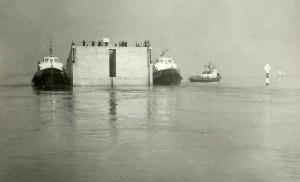Today marks the 60th anniversary of one of the Netherlands' worst natural disasters, the day the North Sea flood waters broke through the dykes holding the North Sea back from the southern portion of the country. In the early hours of February 1st, 1953, large parts of Zeeland, western Brabant and Zuid-Holland flooded. As a result 100,000 people lost their homes and 1,836 people lost their lives. The youngest victim was a baby born on the night of January 31st who drowned later that same night. The horrendous flood was caused by a combination of strong winds, a northwesterly storm, and unusually high spring tides. Around 200,000 hectares of farmland were ruined by the saltwater - to put things into perspective, that amounted to around 10% of Dutch farmland.

As in many horrific natural disasters, there is an abundance of both sung and unsung heroes. Some of the most astounding heroism of the catastrophic flooding was exhibited by the amateur radio operators from all across the country who rushed to the afflicted areas and used their own equipment to set up an emergency radio network in the absence of official channels. Because the flooding occurred on a Saturday night, none of the local radio stations or even the smaller weather stations were broadcasting. None even had staff present in their offices. Consequently, the Royal Netherlands Meteorological Institute's warnings went unheard in the regions that were most vulnerable because telephone and telegraph networks were likewise disrupted. The heroic amateur radio volunteers rapidly organized and worked tirelessly for ten days and nights in the flooded areas maintaining contact with the outside world.

Nevertheless, so devastating were the immediate consequences of the flooding, that neighboring countries send soldiers and aid to assist in the search and rescue process. The US Army Base in Germany even sent helicopters from Germany to rescue people stranded on the rooftops of their houses.
The 1953 Floods are a tragedy that is to the day prominent in the memory of the Dutch. The lives of those who perished with the flood waters are to this day revered. Events are taking place today throughout the areas affected by the 1953 North Sea floods. Even in the small Zuid-Holland village of Oude Tonge, where 305 people lost their lives, there will be a wreath-laying ceremony held to commemorate the dead.
The tragedy also led to great re-evaluation by the Dutch government of the flood management system currently in place to protect its citizens. Coming to the conclusion that such a disaster should never be allowed to strike the Netherlands again, not even in a much smaller incarnation, the government invested billions into the Delta Works flood prevention scheme through which a gigantic system of dykes and sluice gates were built along much of the southern coastline. So massive was the scale of the project that, having begun soon after the 1953 floods, it was fully completed only in 2010. That said, a recent government commission into the ongoing changes in environmental factors has declared that continuous development programs are needed to consistently maintain current satisfactory levels of safety. Over 100 billion euros have been allocated towards flood prevention programs through the year 2100 to counter the effects of global warming as the ecological worst case scenario means that that the country needs to plan for a rise of 1.3 meters in the levels of the North Sea in that time period.

The levels of expertise that the Dutch have attained in flood management as a result of the 1953 floods have made them prime advisers to other countries battling rising sea levels. Among many other national representatives, environmental officials from agencies dealing with both Hurricane Katrina and Hurricane Sandy repairs have toured the Delta Works and consulted with their Dutch counterparts. Because of the tremendous suffering the Dutch experienced first-hand in 1953, they are incredibly willing to divulge their secrets in order to help others avoid similar situations.

© 2013, Amsterdam City Tours Blog. All rights reserved. On republishing any part of this post, you must provide a link back to this original post

